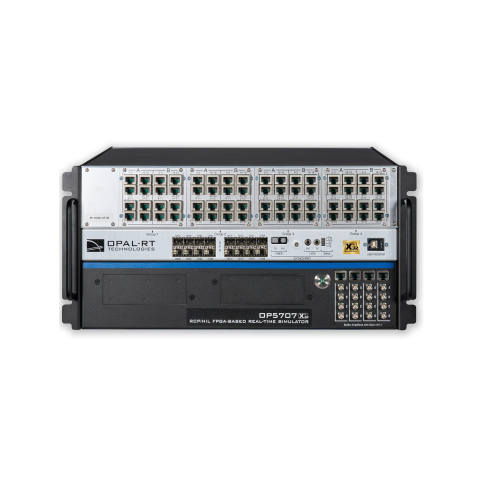Charging
Electrification has increased the demand for reliable charging solutions, driving the need for advanced testing methods. We specialize in grid testing and power electronics technology, offering the high-performance eHS solver renowned for its speed and flexibility in advanced simulations. Engineers and scientists benefit from our solutions as they adapt to current industry standards, deliver high-fidelity simulations, and scale effectively across various testing scenarios—from component-level validation to comprehensive system-level testing.

They trust us



Challenges
Meeting the rigorous testing needs of charging applications
On-board chargers (OBCs), which convert AC to DC power, now operate at higher switching frequencies (100-500kHz) to reduce passive components and enhance efficiency. Offboard charging stations (EVSE) must meet rigorous standards for compatibility, reliability, and compliance with diverse grid requirements.
The testing demands are intricate, involving the capture of high-resolution gating signals and the real-time simulation of complex converter models. Co-simulation combining CPU and FPGA technologies allows for the simultaneous testing of slow and fast dynamics within charging systems.
Demo
Bringing on-board charger (OBC) models to real-time
Watch this video showcasing a real-time simulation of an on-board charger (OBC) powered by the cutting-edge eHS high-performance solver and the OP4610XG simulator. Discover how our solution delivers unparalleled precision and resolution in controlling power electronics devices with fast switching signals up to 180kHz.
Advantages
Why choose us for your high-demand EV charging simulation solutions?
Our eHS high-performance solver provides the fastest, most precise power electronics simulations, enabling accurate modeling of high-frequency switching essential for OBC and EVSE. With seamless FPGA integration, full schematic customization, and co-simulation capabilities, we ensure efficient and reliable testing of complex converter models and control systems.
1
The fastest solver on the market
2
Full schematic customization
3
Seamless FPGA integration
4
Co-simulation capabilities
Research and Innovation
Advanced testing solutions for electric vehicle supply equipment (EVSE)
Leverage our expertise in power systems and power electronics for your EVSE testing needs. Our platform simulates real-world conditions and utilizes Hardware-in-the-loop (HIL) technology to ensure your EVSE products meet top performance and safety standards, whether testing the connection to the grid, to the EV, or for battery charging simulation. We also offer support for various industrial protocols and integration services to expand your testing capabilities. Explore the following presentations to gain deeper insights into the latest advancements in EVSE technology.
Solutions
Studying the effects of electric vehicle charging and Vehicle-to-Grid (V2G) technology on the grid
As the global electrified fleet grows, uncontrolled charging poses risks like under-voltages and network congestion. Reduce network losses and test different charging methods with our hardware platforms and software suites, allowing you to simulate power electronics components and the electric network in real-time. Due to our proven expertise in power systems simulation, we are also the ideal partner for testing your innovative V2G control approaches and their grid impacts.

FAQ
Find the answers to your questions
Do I need hardware-in-the-loop testing?
To find out more about hardware-in-the-loop testing, visit our page here.
To discuss your specific application needs, don’t hesitate to contact us.
What communication protocols do you support?
Consult our comprehensive list of supported protocols here.
How does OPAL-RT’s advanced testing system support EV charging simulation?
Our testing system utilizes a high-performance eHS solver with seamless FPGA integration to deliver fast and precise simulations. This capability is critical for EV charging simulation, where capturing high-frequency switching and transient behavior is essential. In addition, the platform supports battery charging simulation and wireless charging simulation, allowing engineers to evaluate different charging architectures, all while meeting current industry standards.
What are the advantages of incorporating wireless charging simulation into charging system testing?
Wireless charging simulation enables the analysis of contactless energy transfer methods, allowing for testing of inductive coupling, power transfer efficiencies, and signal integrity in a virtual environment. Our system not only provides wireless charging simulation but also integrates battery charging simulation and EV charging simulation. This holistic approach ensures that every aspect of the charging ecosystem is validated under realistic conditions, ensuring optimal performance and safety across diverse applications.
How do OPAL-RT’s simulation tools ensure accurate power electronics performance during charging tests?
Our simulation tools, powered by the eHS solver, offer the high-speed and flexible modeling required to accurately recreate the conditions experienced during charging events. This enables detailed battery charging simulation by reproducing high-frequency switching phenomena and transient states. In parallel, our platform supports EV charging simulation to test on-board chargers and EVSE performance, as well as wireless charging simulation to examine contactless power transfer. The result is an end-to-end validation that minimizes development risk and enhances overall system reliability.
Can your testing solutions be adapted for various charging simulation scenarios?
Yes, our open and customizable hardware-in-the-loop (HIL) systems are designed to adapt to a wide range of charging simulation scenarios. Whether it’s battery charging simulation to optimize charging curves, EV charging simulation to validate on-board and off-board equipment, or wireless charging simulation for emerging contactless technologies, our platform is engineered for scalability and flexibility. This modular approach means that as industry standards change, our tools can easily be reconfigured to meet new testing requirements, ensuring comprehensive validation from component-level checks to complete system-level integration.
EXata CPS has been specifically designed for real-time performance to allow studies of cyberattacks on power systems through the Communication Network layer of any size and connecting to any number of equipment for HIL and PHIL simulations. This is a discrete event simulation toolkit that considers all the inherent physics-based properties that will affect how the network (either wired or wireless) behaves.







